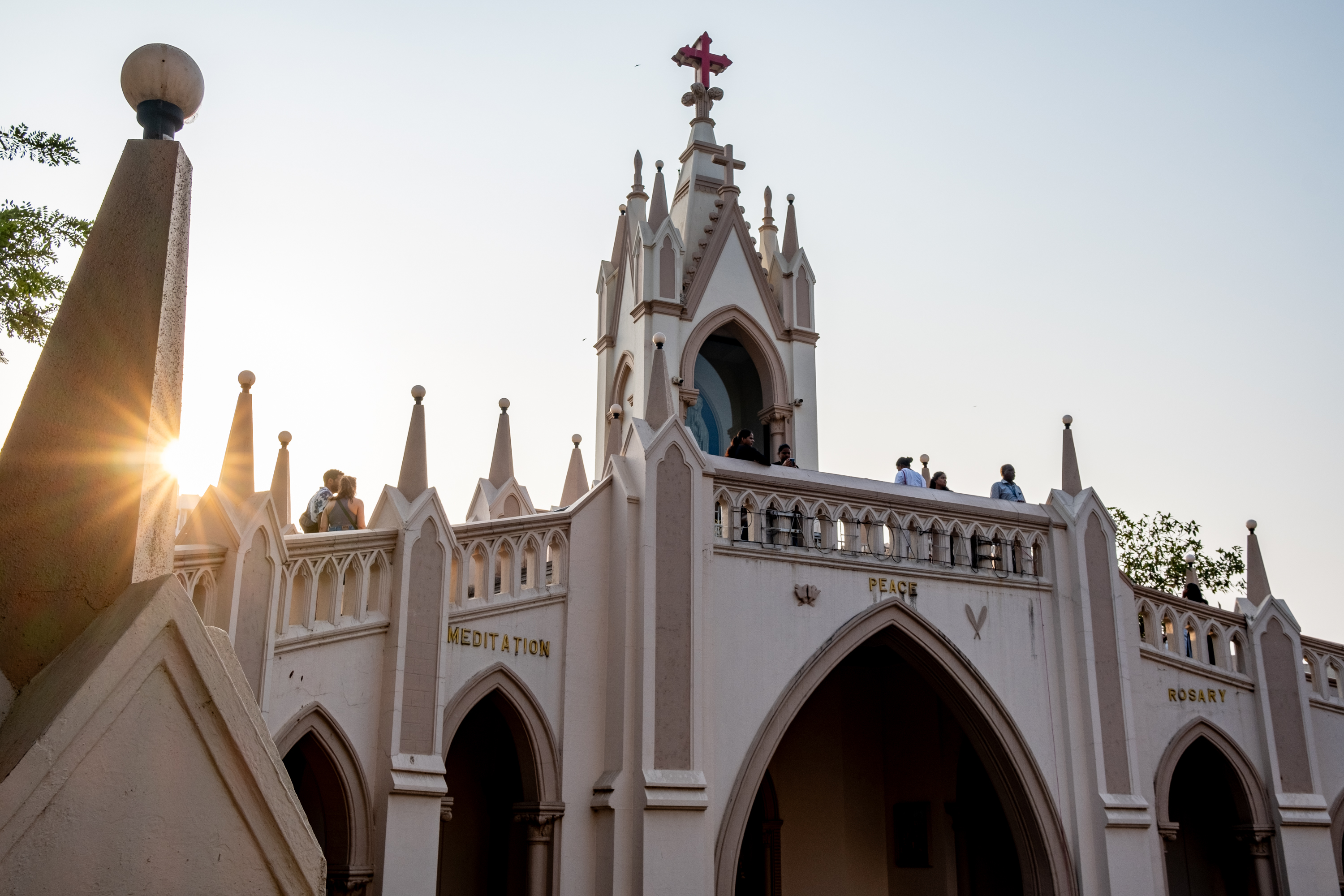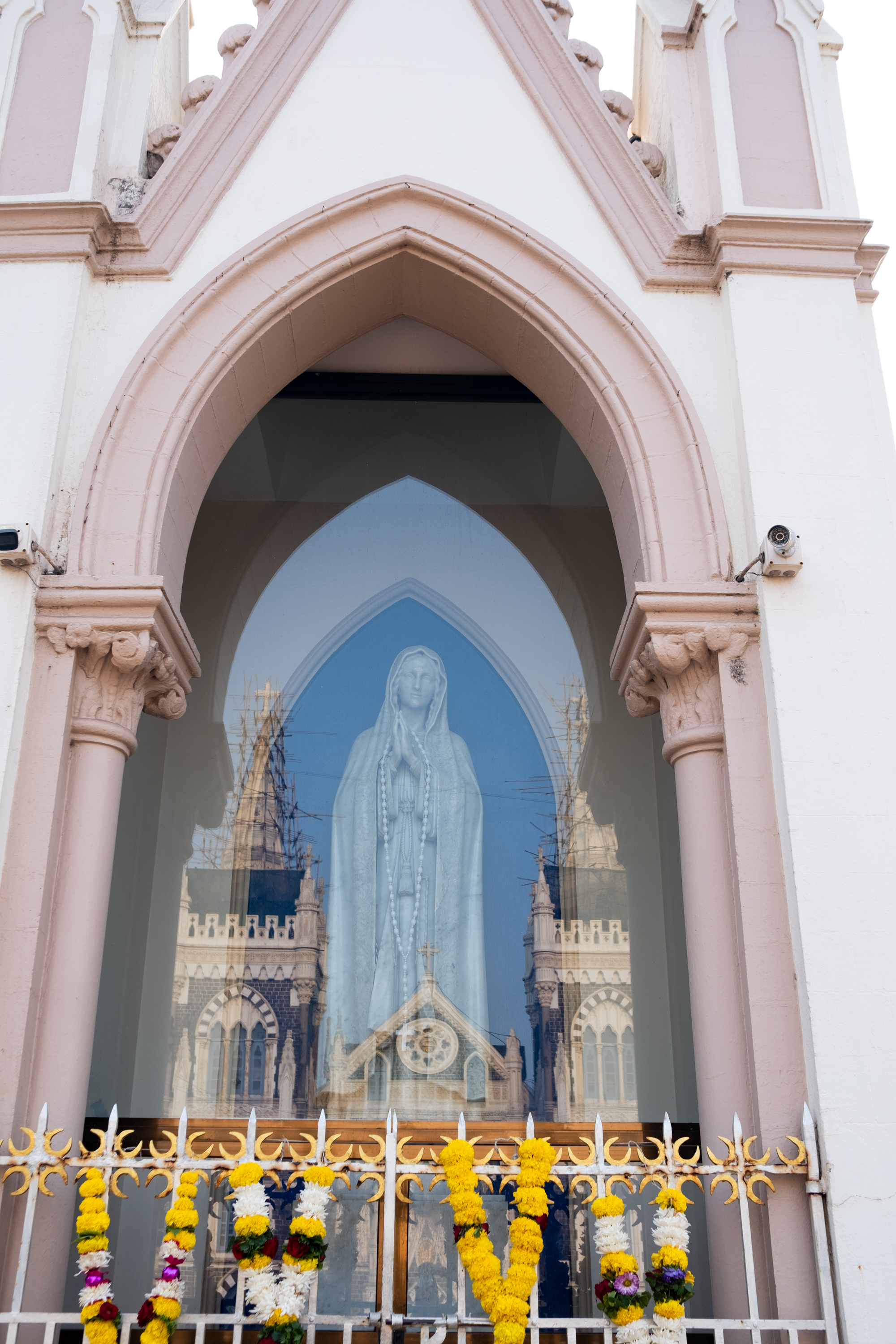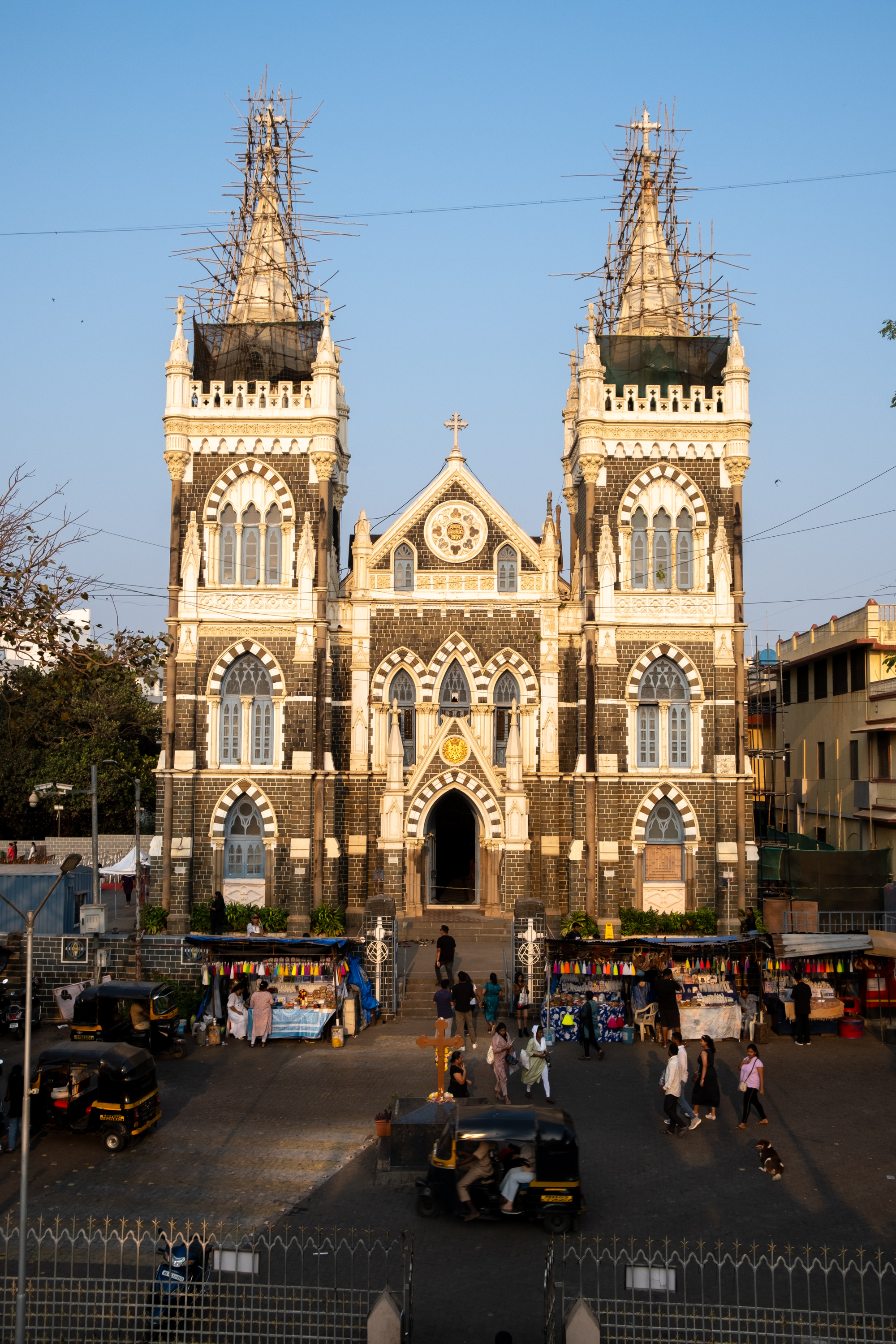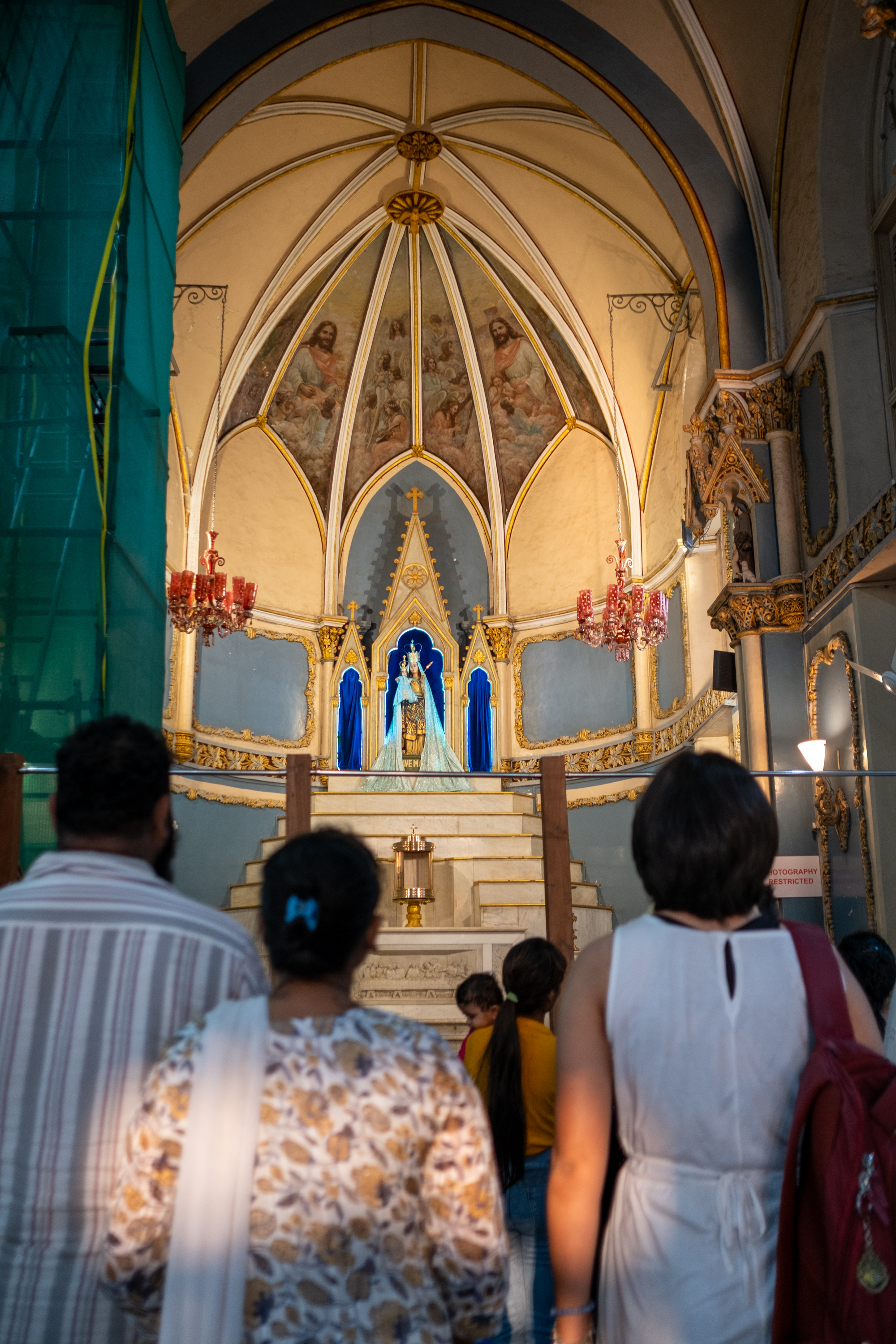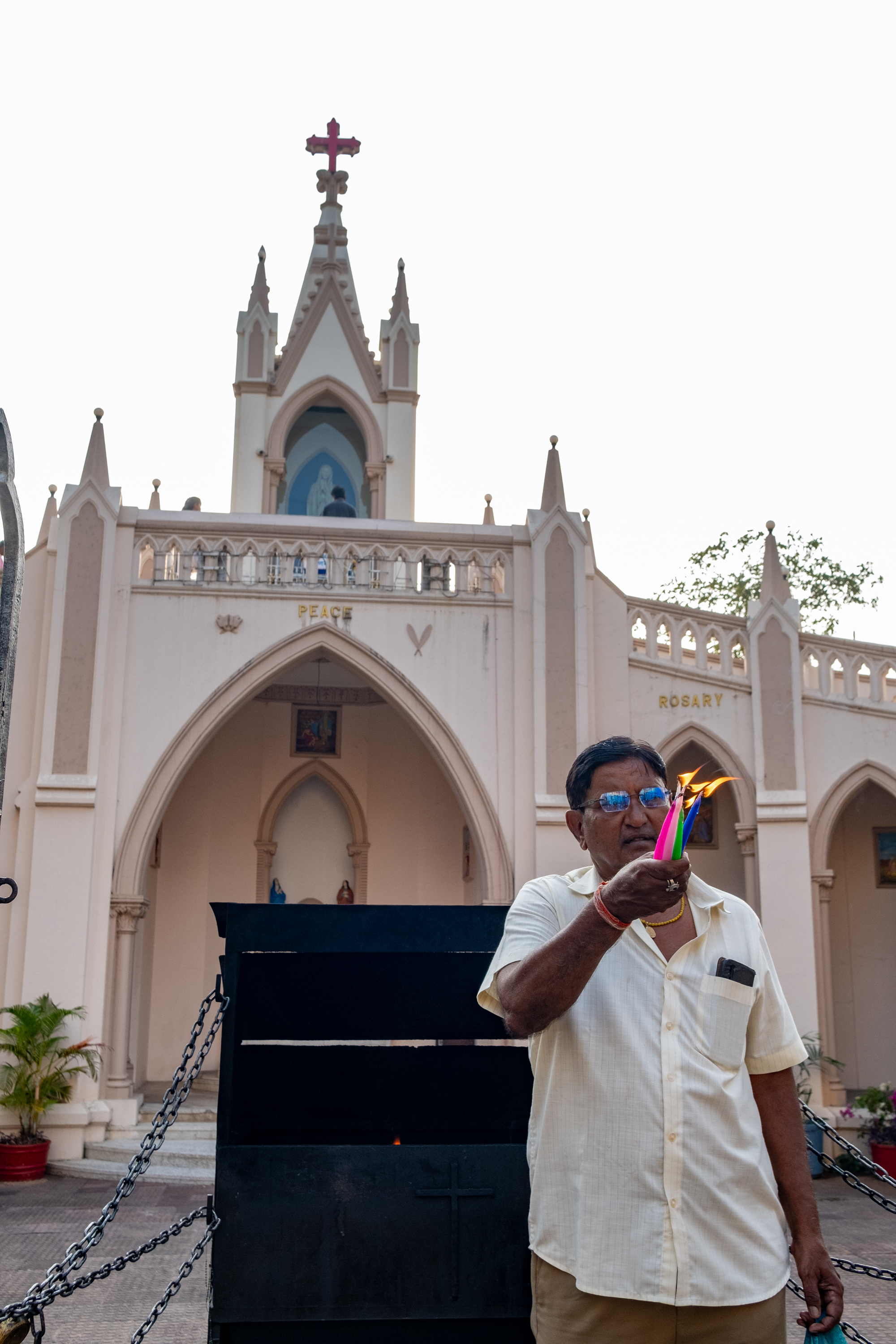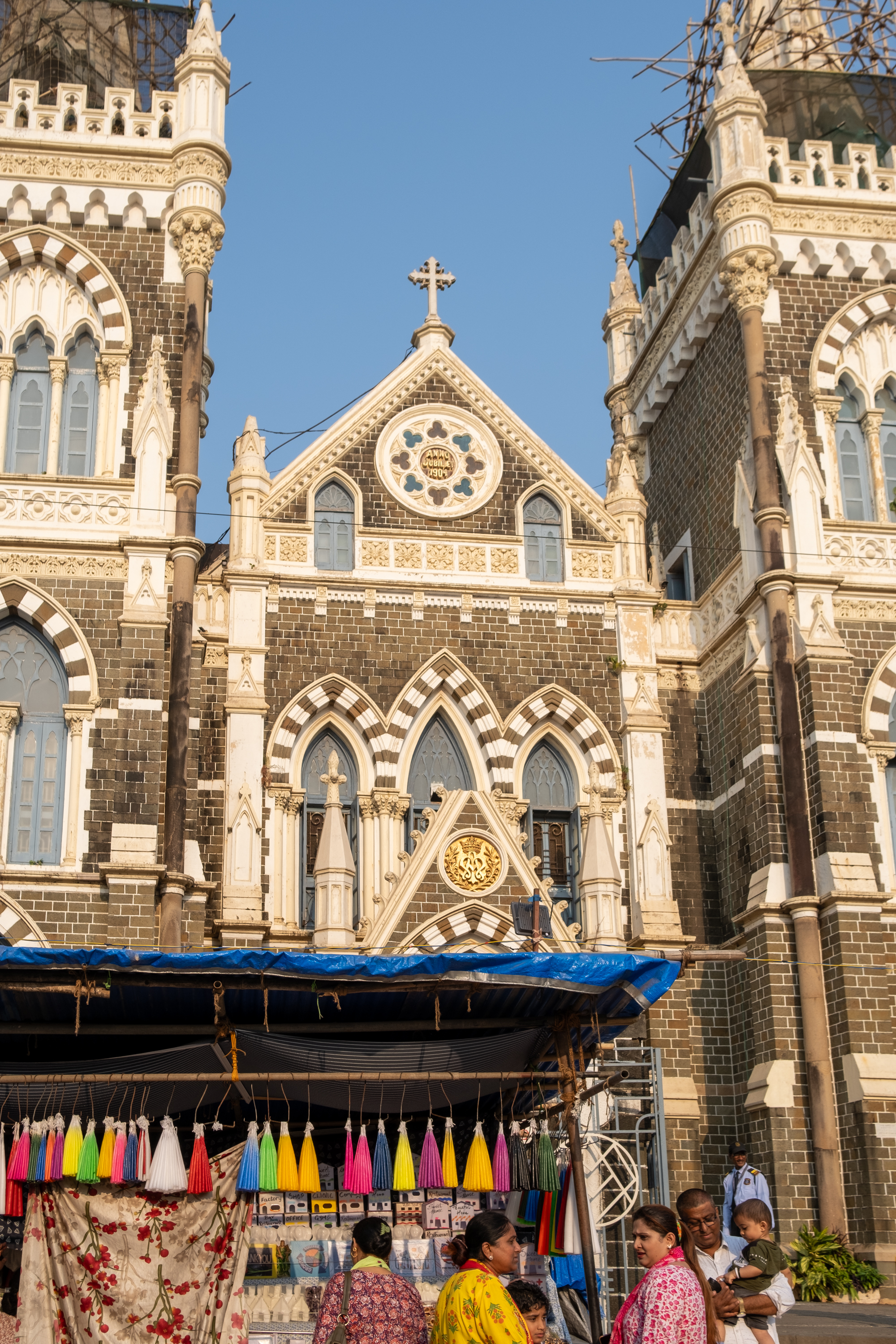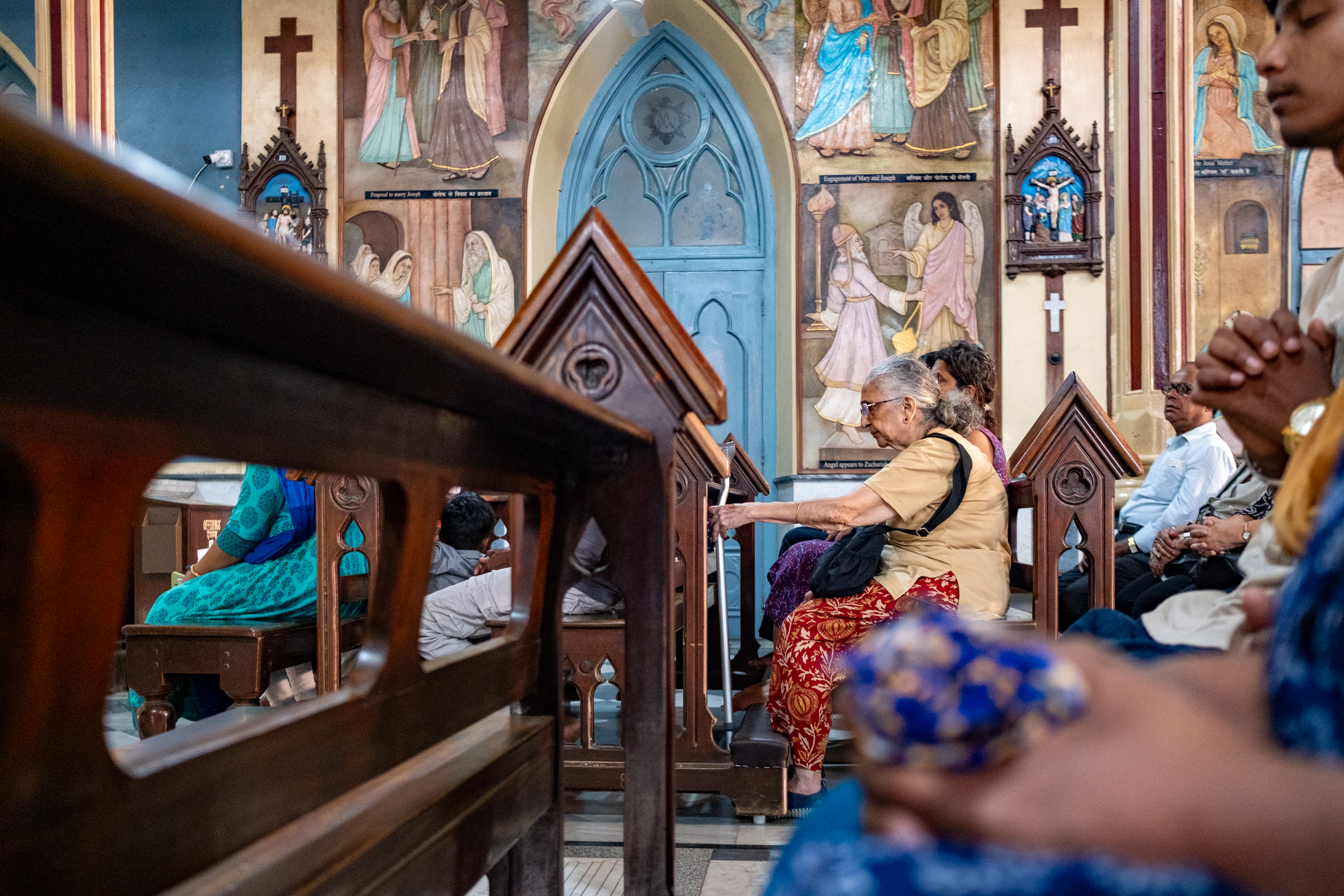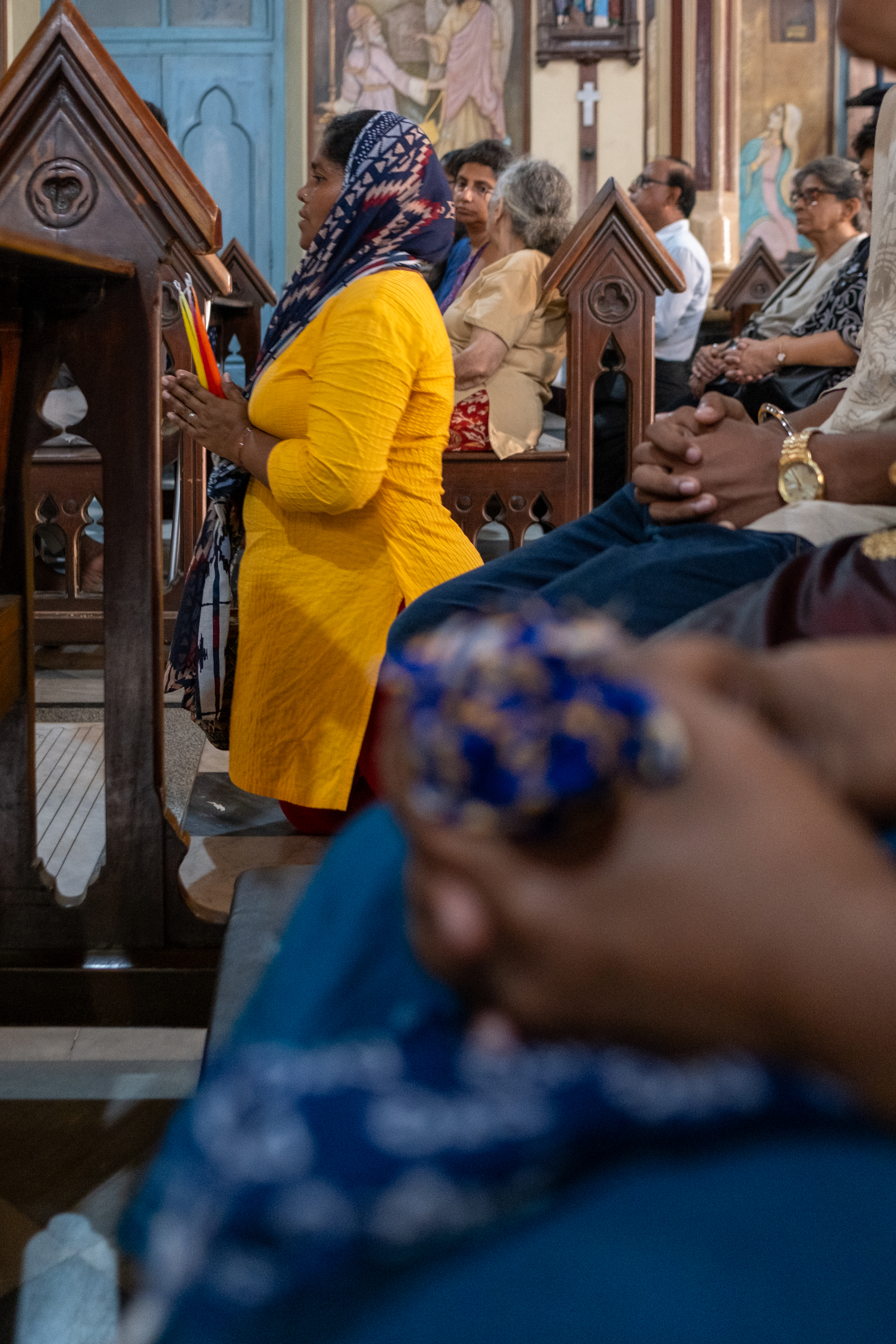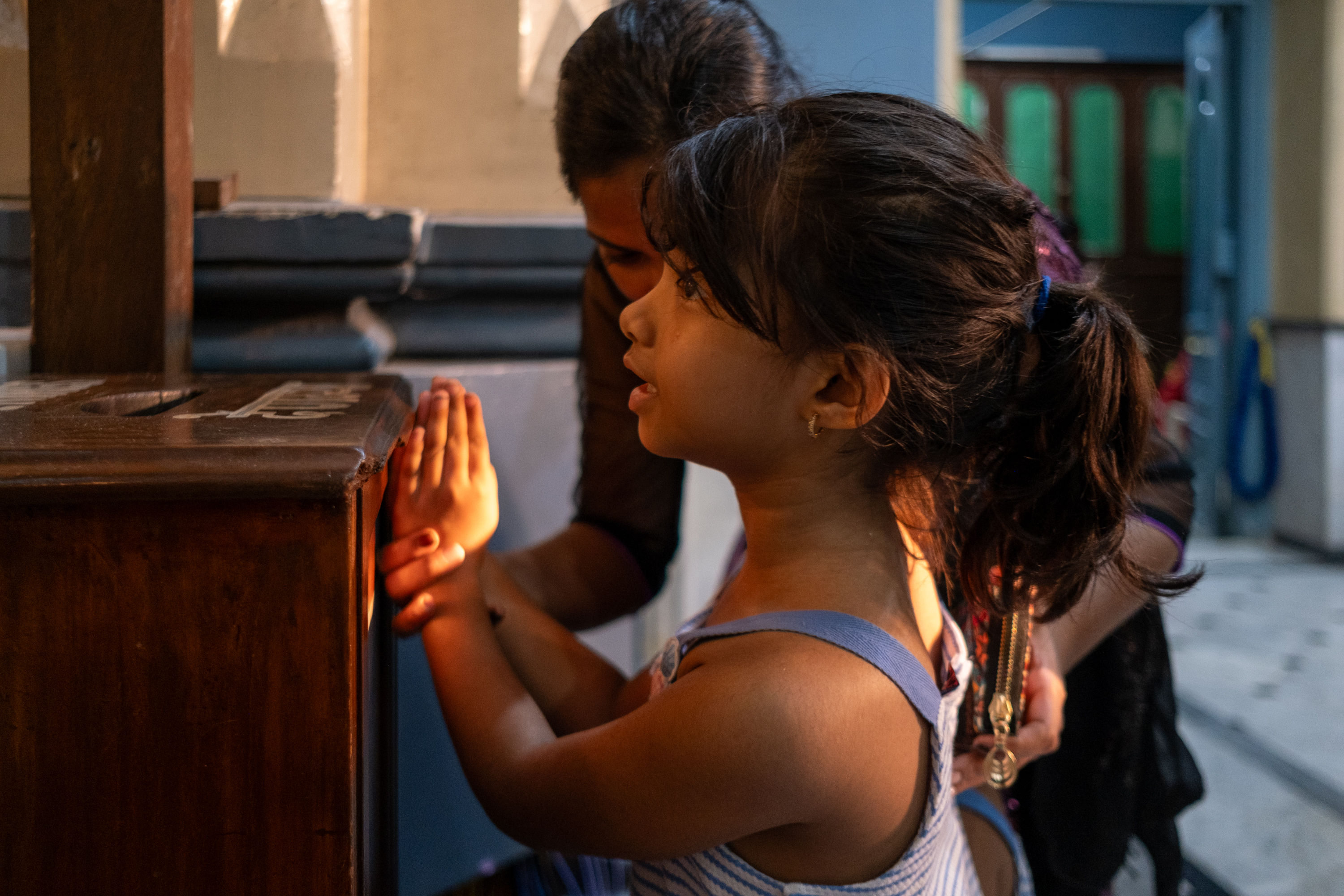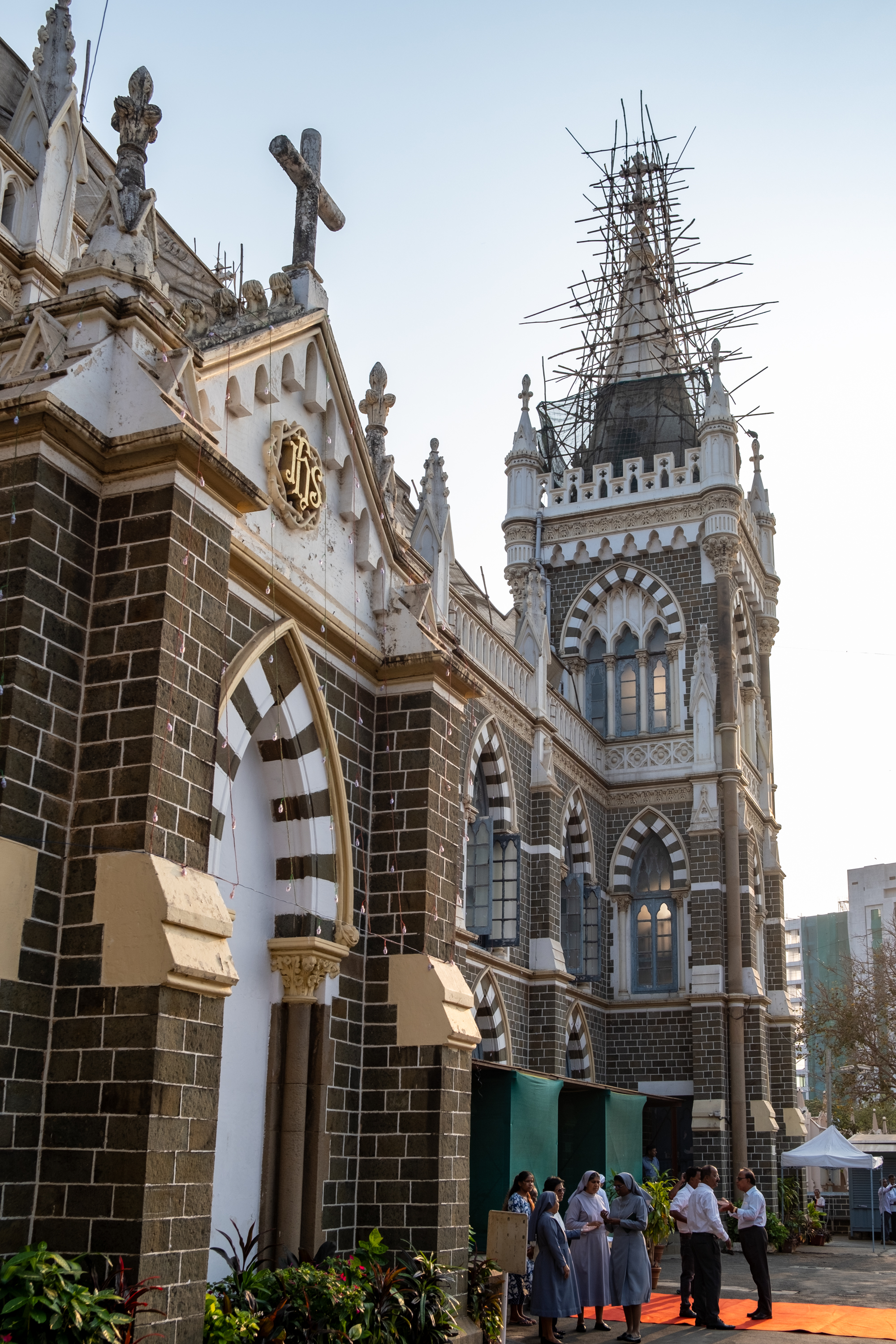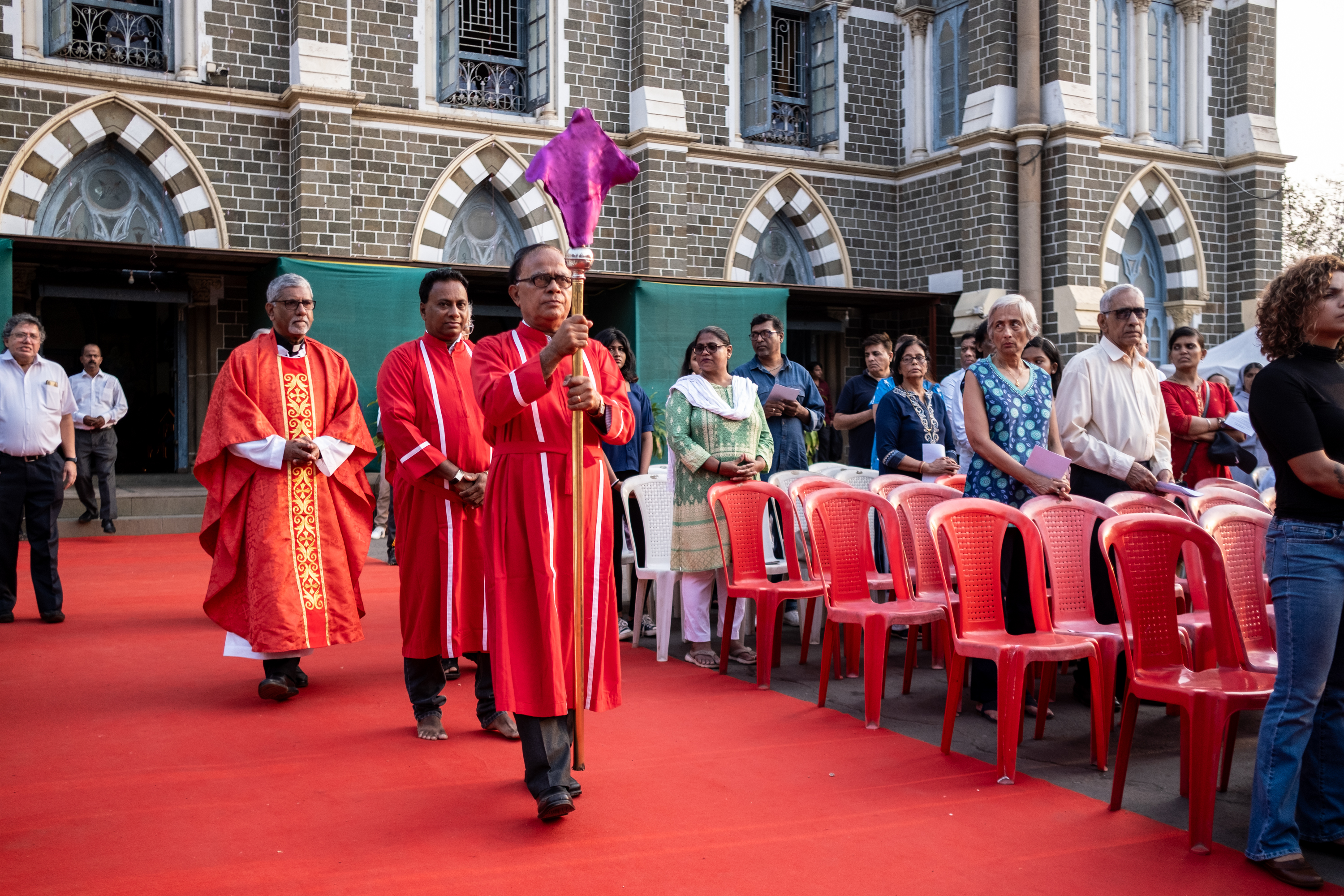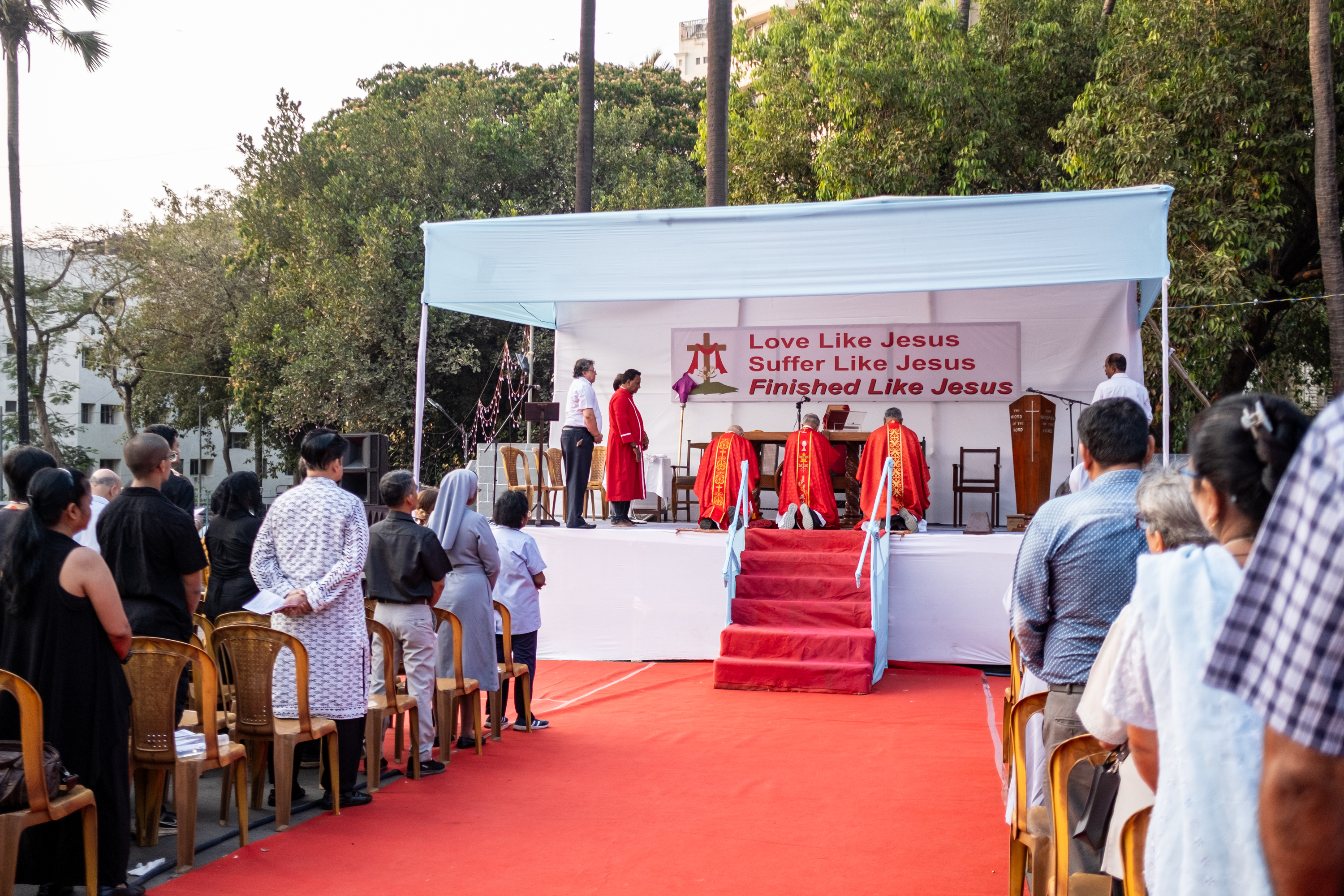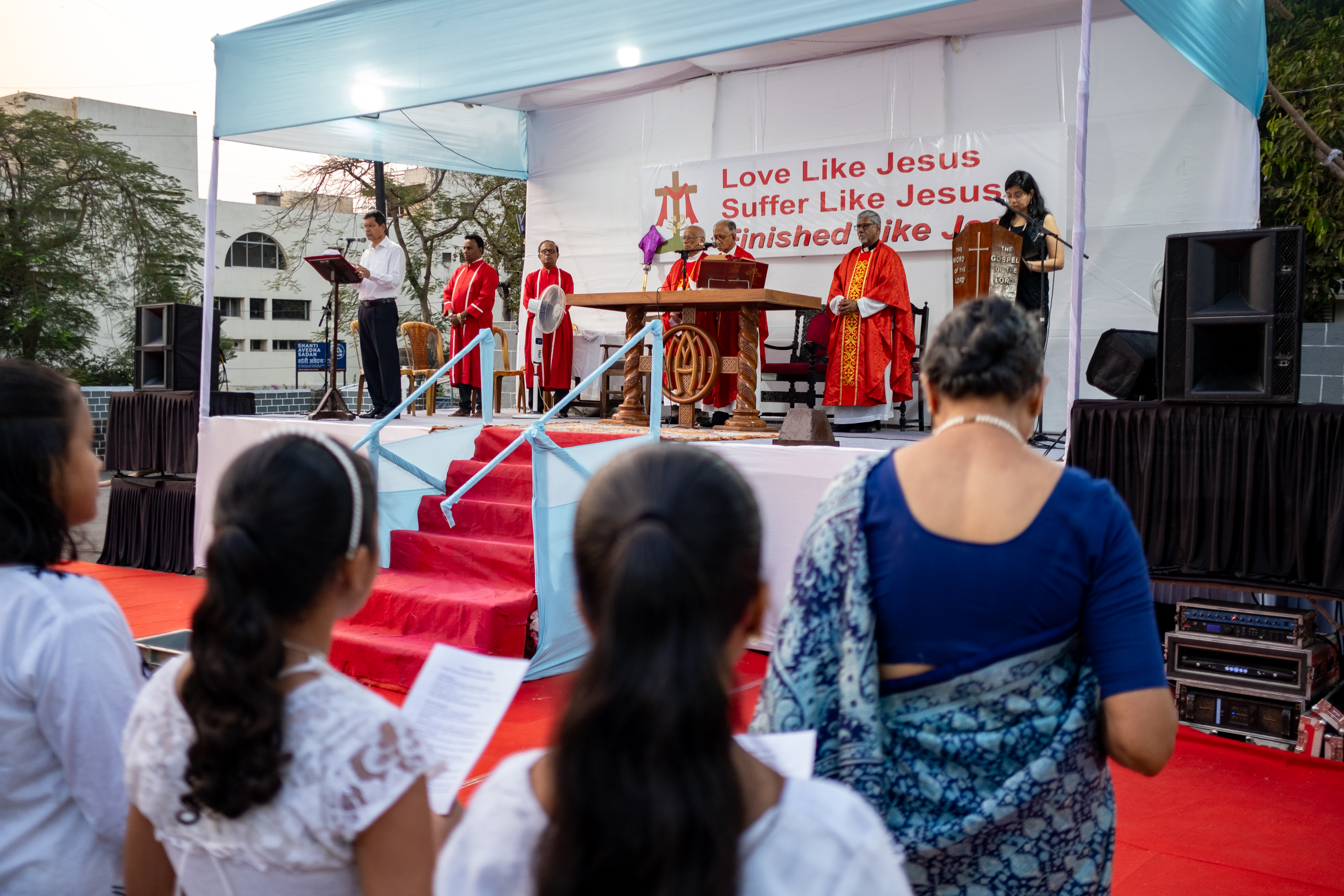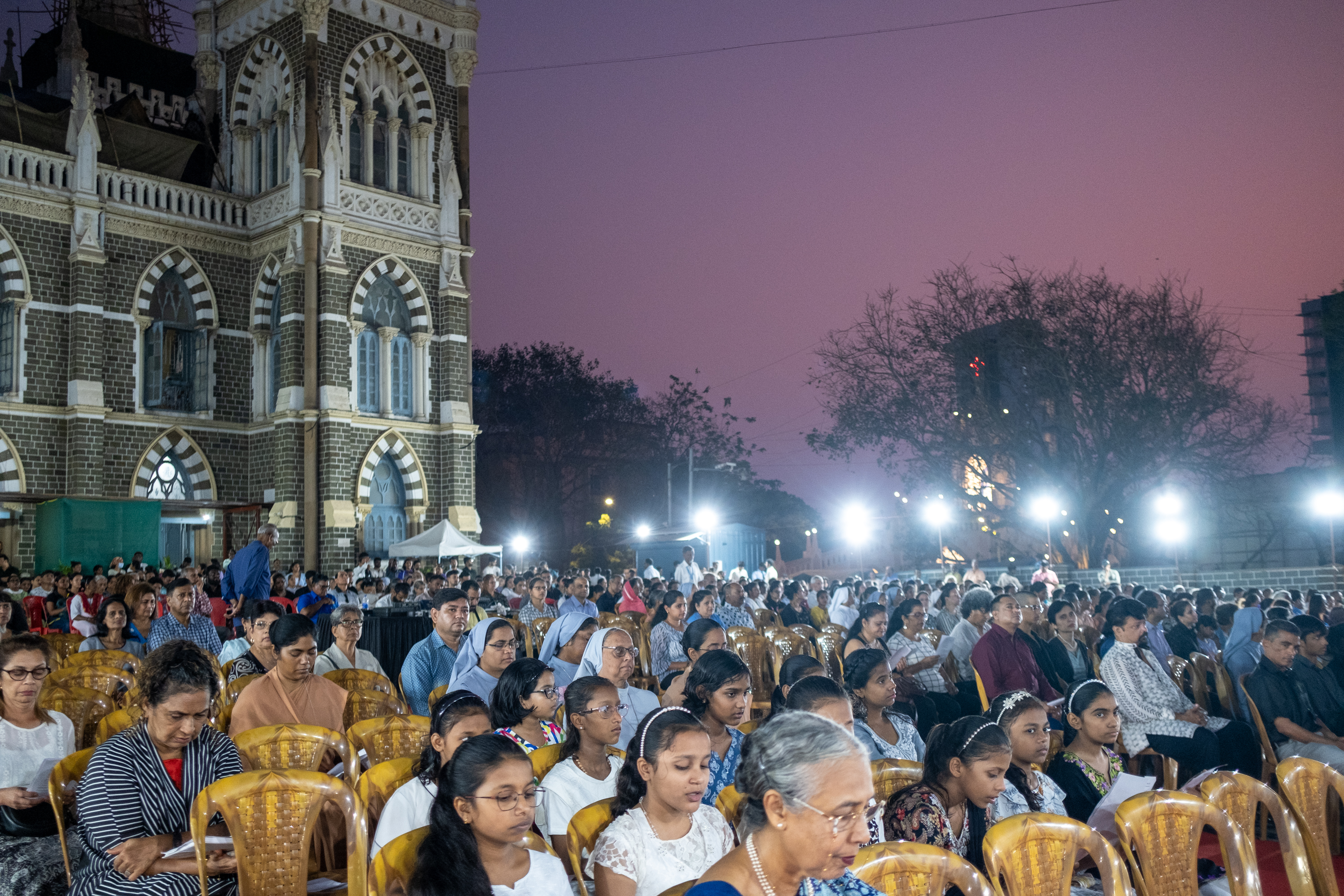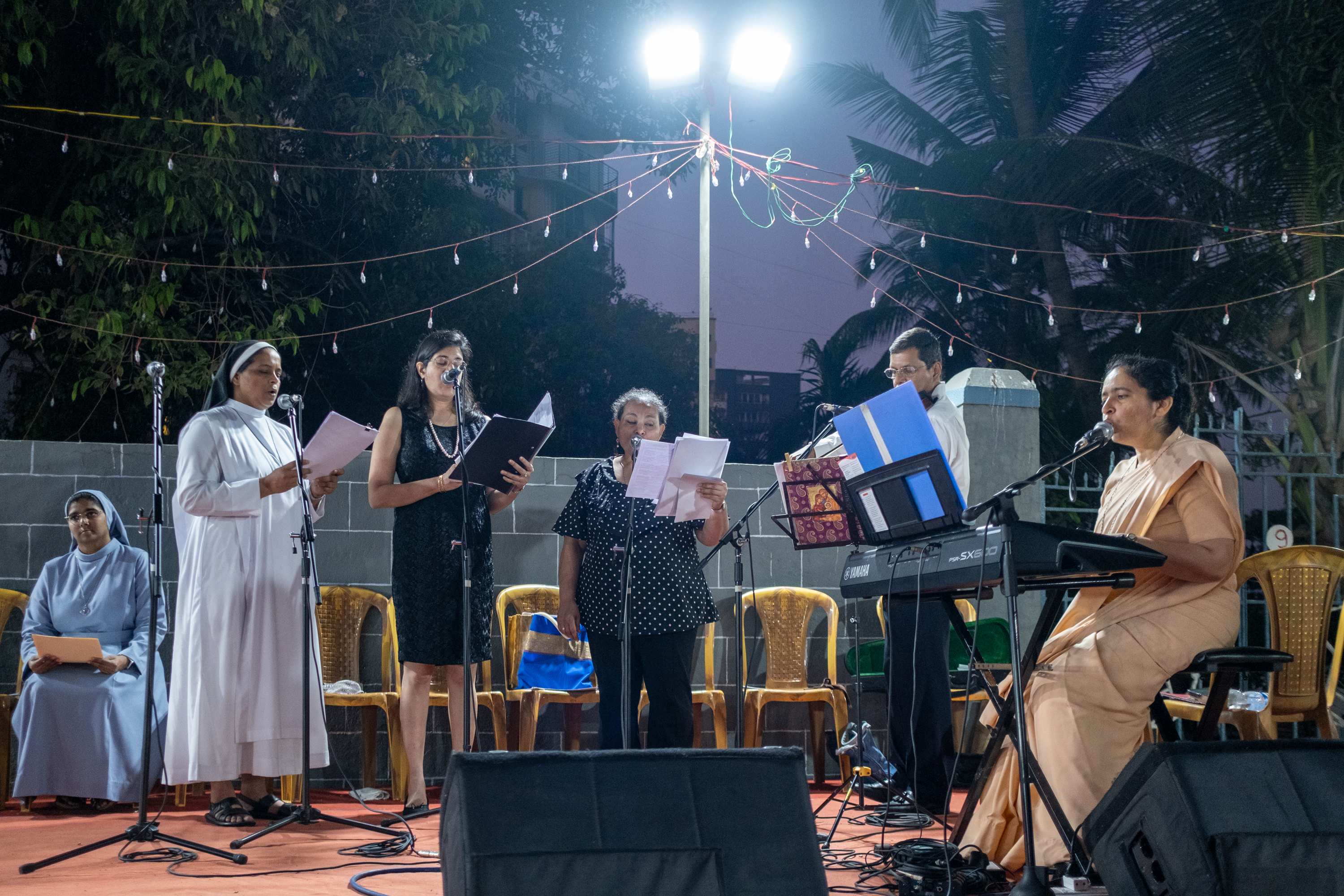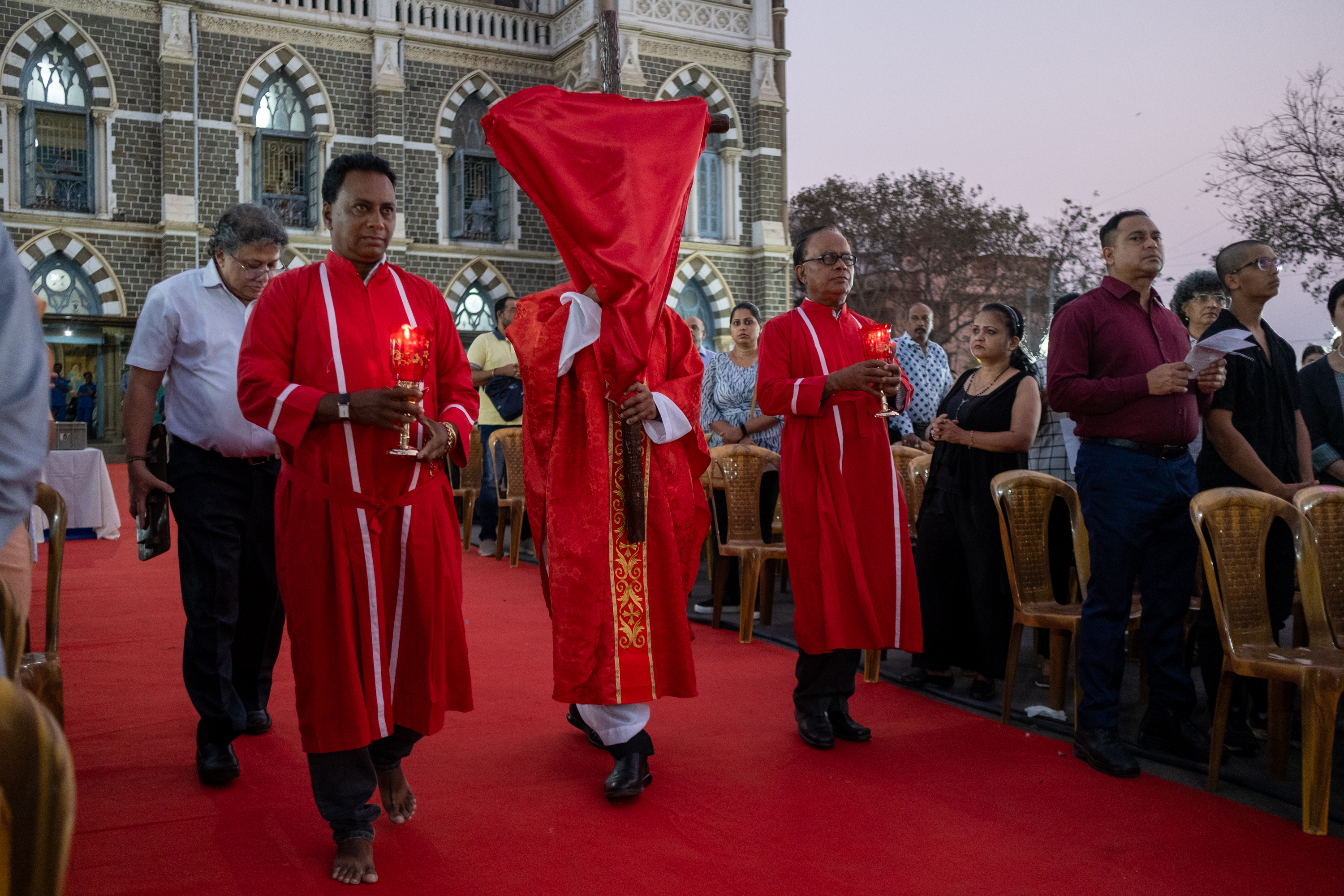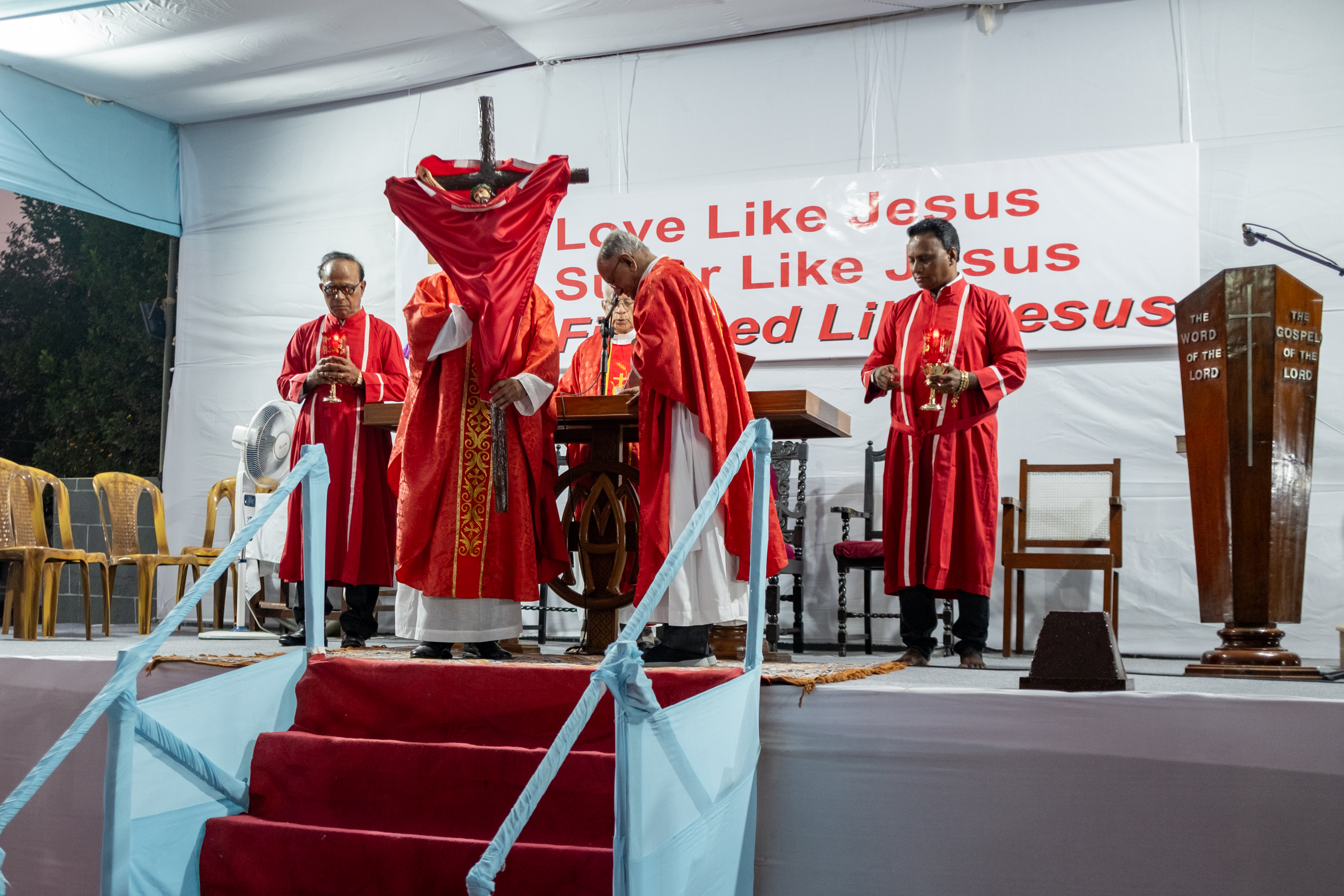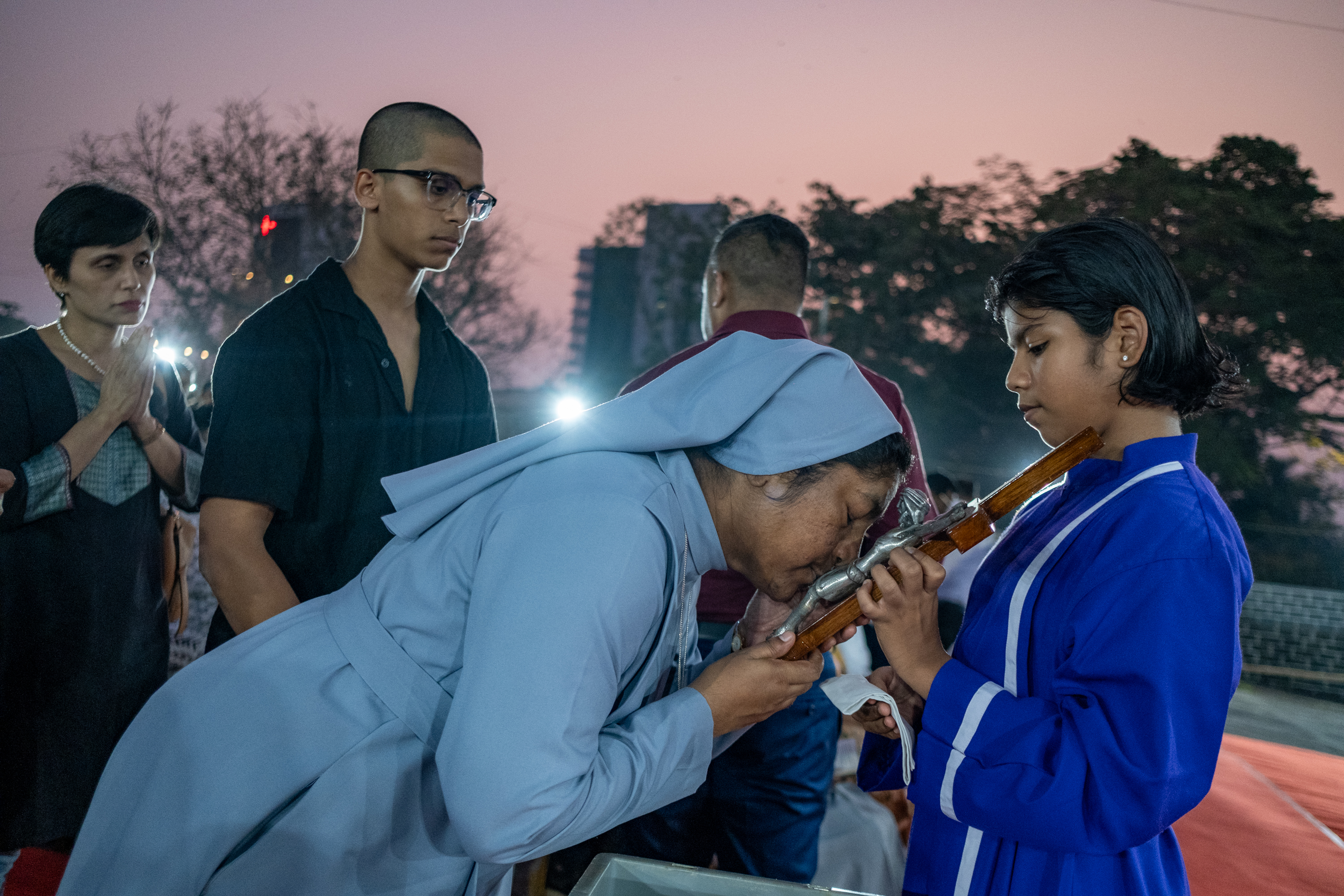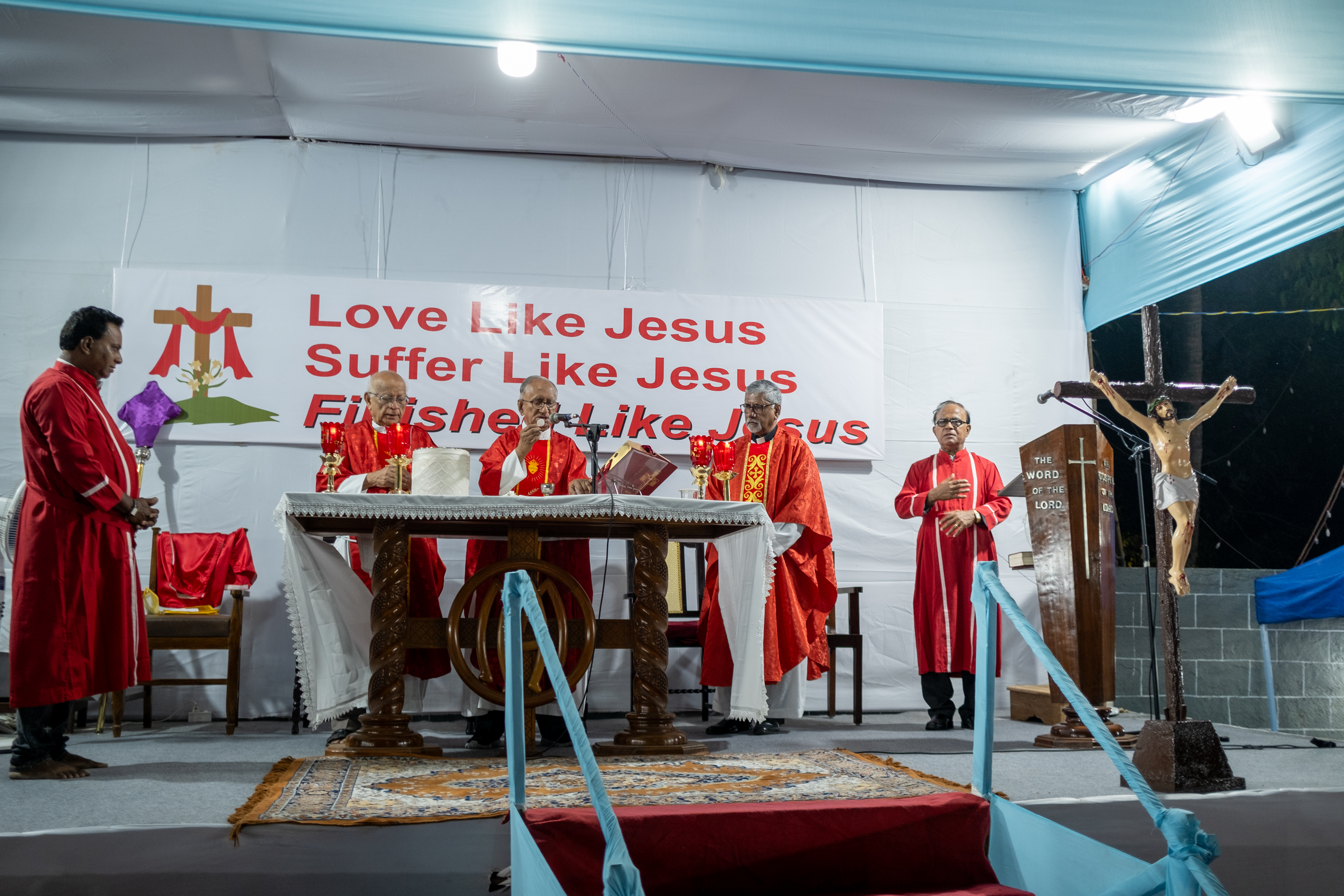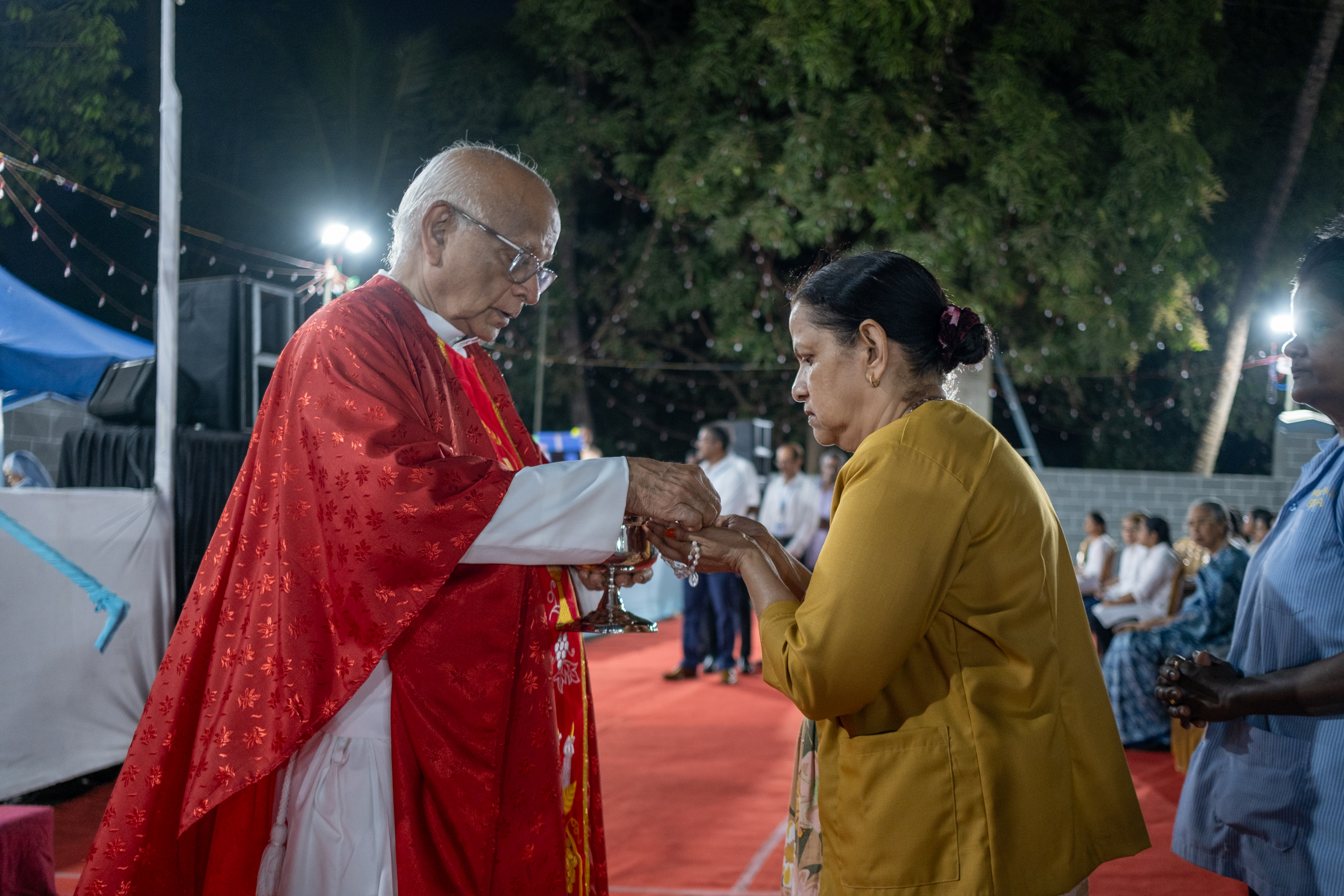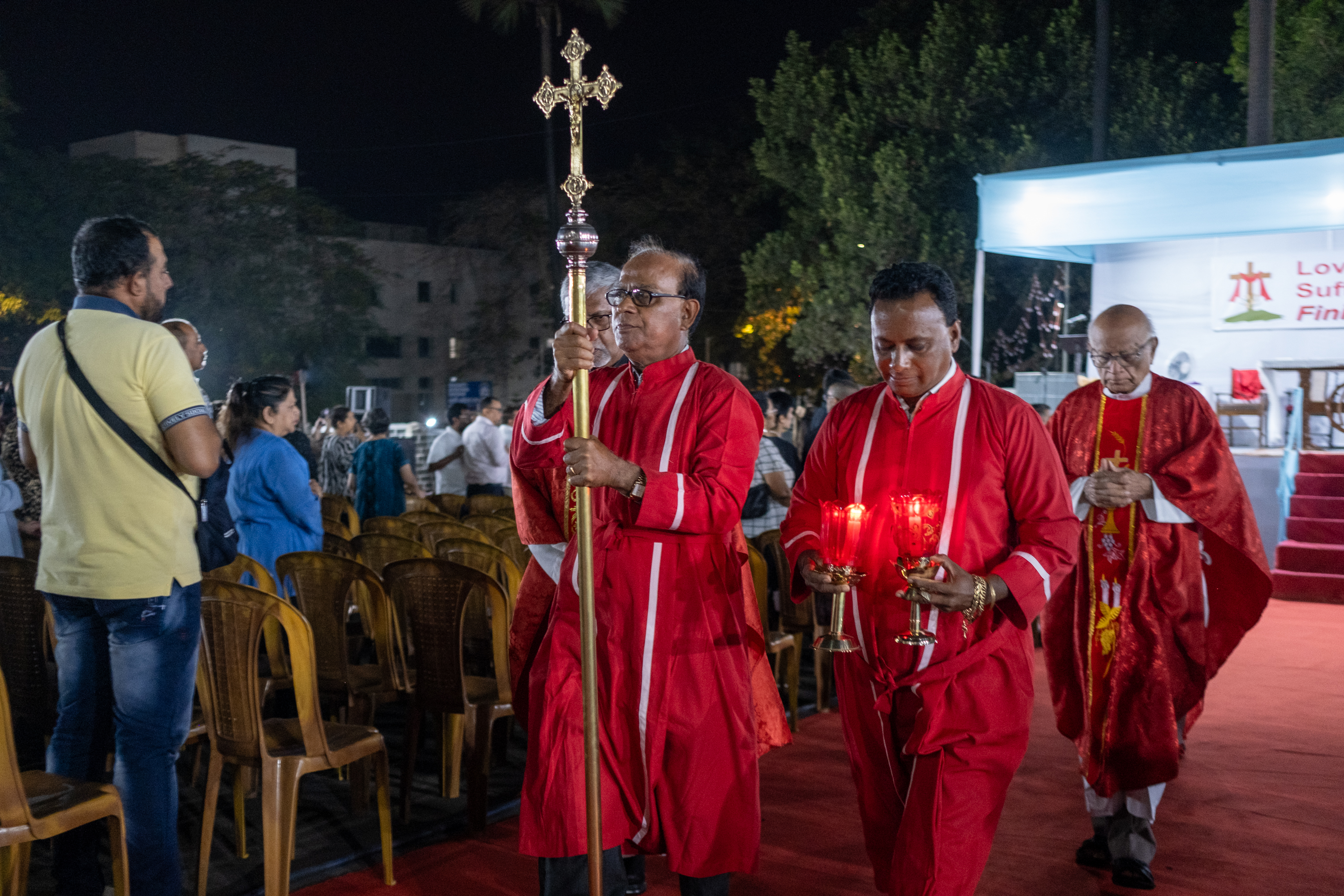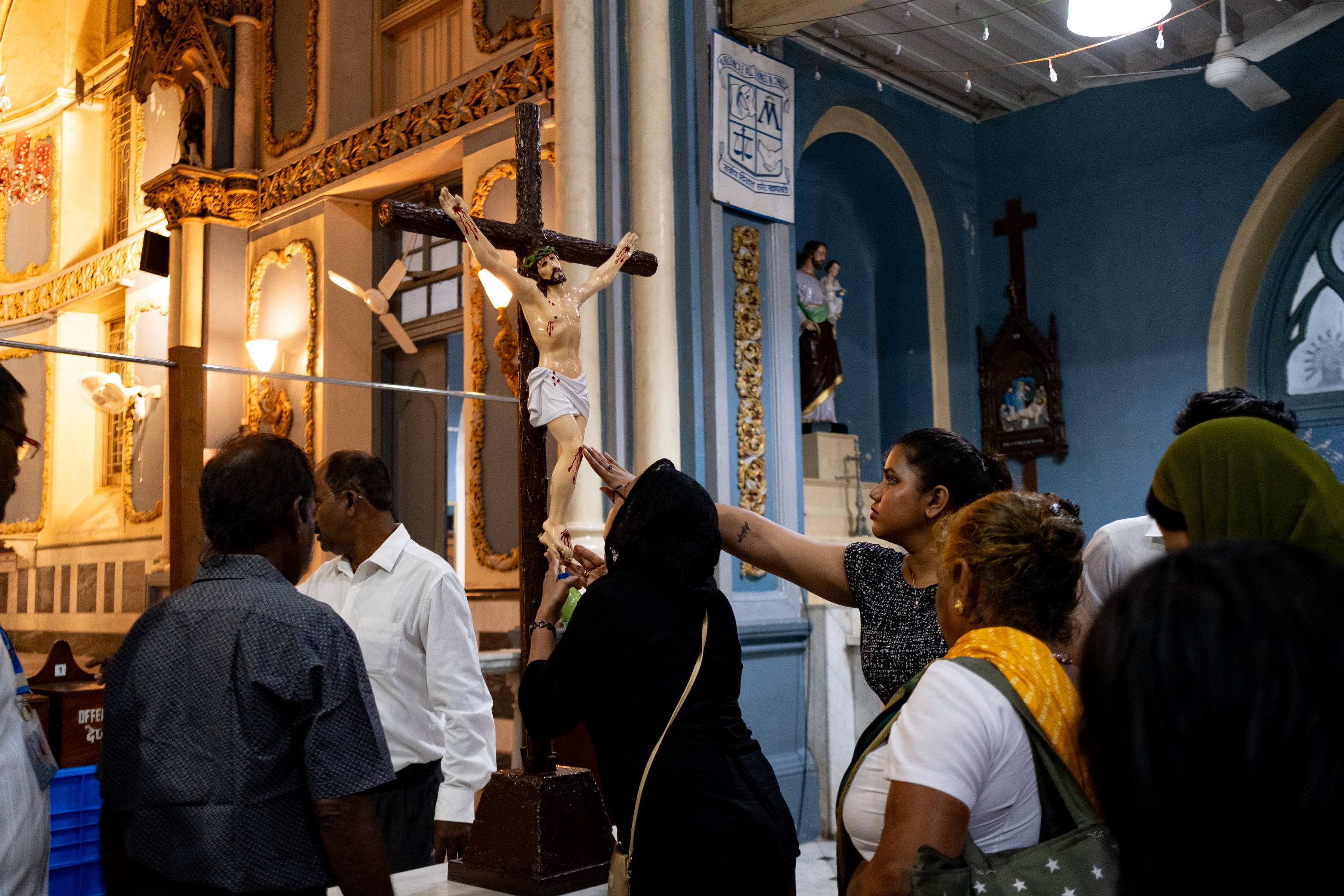Reverence and Reflection: Observance of Good Friday at Mount Mary Basilica, Bandra
Mount Mary Basilica, a prominent pilgrimage site in Bandra, Mumbai, is dedicated to the Blessed Virgin Mary. The devotion to Mary, known as Marian devotion, is a central aspect of Catholic spirituality and is particularly strong at this basilica. The basilica attracts thousands of visitors, especially during the annual Bandra Fair, held on September 8 to coincide with the Feast of the Nativity of Mary. Catholics visit to seek her intercession in troubled times, pray for miracles, and offer thanksgiving for fulfilled vows and wishes. Over the years, the basilica has become a significant pilgrimage site for many Catholics.
The basilica, a historic landmark in Mumbai, has a rich history dating back to the 16th century CE. It began as a mud-built oratory erected by the Portuguese in 1570, when they ruled Bandra and the rest of Mumbai. According to tradition, a Jesuit priest brought a statue of the Virgin Mary from Portugal and installed it in the oratory, which in 1640 was expanded into a chapel. The current structure is a blend of Gothic and Indian architectural styles and was opened to the public in 1904 on the Golden Jubilee of the Promulgation of the Dogma of the Immaculate Conception. In 1954, Pope Pius XII elevated the church to the status of a minor basilica, recognising its historical, spiritual, and architectural significance.
Good Friday, observed on the Friday before Easter Sunday, attracts numerous devotees to Mount Mary Basilica, both from the local community and visitors. The church accommodates the extra congregation with additional seating or outdoor arrangements. Good Friday is marked by mourning, reflection, and devotion as Catholics remember the suffering and sacrifice of Jesus Christ for humanity’s salvation. The day is considered ‘good’ because it is believed to be the day when Jesus Christ, through his sacrificial death on the cross, redeemed humanity from sin and opened the way to salvation and eternal life. The term ‘good’ in this context likely originates from an older meaning of the word, which meant ‘holy’ or ‘pious’.
The observance of Good Friday starts with Lent, a 40-day season (excluding Sundays) that mirrors Jesus’ 40 days of fasting in the desert while enduring temptation by Satan. The final week of Lent, known as Holy Week, commemorates the passion, death, and resurrection of Jesus Christ. Palm Sunday marks the beginning of Holy Week, commemorating Jesus’ entry into Jerusalem, where crowds welcomed him with palm branches. The next three days, Holy Monday, Holy Tuesday, and Holy Wednesday, will continue the commemoration of events leading up to Jesus’ crucifixion. Traditions and liturgies during these days may include the anointing of Jesus at Bethany, the cursing of the fig tree, and the prediction of Judas’ betrayal.
Maundy Thursday commemorates the Last Supper, during which Jesus instituted the sacrament of the Eucharist. During this communal meal, Jesus took bread and wine, blessed them, and gave them to his disciples, saying, ‘This is my body’ and ‘This is my blood’. This event is foundational for the Catholic belief in the real presence of Christ in the Eucharist. Jesus also washed the feet of his disciples, symbolising the call to serve others with humility and love. The evening Mass of the Lord’s Supper includes the washing of the feet, the institution of the Eucharist, and the transfer of the Blessed Sacrament to an altar of repose. The faithful are invited to spend time in prayer and reflection, keeping vigil with Jesus in his hour of agony.
The main liturgical service on Good Friday is the Liturgy of the Lord’s Passion, typically held in the afternoon. This includes the reading of the Passion narrative from the Gospel of John, solemn intercessions, veneration of the cross, and distribution of Holy Communion (using hosts consecrated on Maundy Thursday). Catholics reflect and pray before the altar of repose. The atmosphere in and around the basilica is one of quiet reflection and mourning. Some choose to receive the sacrament of reconciliation (confession) on Good Friday as part of their spiritual preparation and repentance. Additionally, acts of charity and generosity are encouraged, with donation drives organised to support the less fortunate within the community. The church runs schools, healthcare facilities, and various charitable activities, providing support to the underprivileged.
Many Catholics also participate in the Stations of the Cross on Good Friday, also known as the Way of the Cross or Via Crucis. This devotional practice in Catholicism commemorates the events of Jesus Christ’s Passion and crucifixion. It consists of 14 stations, each representing a specific event that occurred during Jesus’ trial: his condemnation, meeting with Mother Mary, his struggle to carry the cross along Via Dolorosa, the crucifixion at Golgotha, death, and burial. The 14 Stations of the Cross are inside the basilica, arranged along the aisle, seven on each side. The faithful move from station to station, offering prayers and reflections at each station.
The next day, Holy Saturday, marks the time Jesus lay in the tomb. Jesus’ burial in a new tomb symbolises the hope of new life and offers believers a new beginning and the promise of eternal life. It is a day of silence and reflection, with no mass celebrated during the day. The liturgy begins with the blessing of the new fire and the Paschal candle. It includes the singing of the Exsultet, multiple scripture readings recounting salvation history, the blessing of water, the renewal of baptismal promises, and the celebration of the Eucharist. The Easter Vigil, held on the night of Holy Saturday, is the most important liturgy of the year, marking the end of Lent and the beginning of the celebration of the Resurrection.
The burial of Jesus is a pivotal moment in the Passion narrative, connecting the sorrow of Good Friday with the joy of Easter Sunday, which celebrates the Resurrection of Jesus Christ. This day signifies triumph over death, the fulfilment of prophecy, the promise of eternal life, and the renewal of faith, marking the end of Holy Week and the beginning of the Easter season. As Holy Week draws to a close, the Catholic community emerges from their collective observance of Good Friday with a renewed sense of faith and devotion.
Catholic pilgrims visiting the basilica also visit the oratory facing Mount Mary Basilica, dedicated to Our Lady of Fatima, offering prayers and candles. Prayers are also offered to a small shrine, the Road Cross, placed in the middle of Mount Mary Road, which separates the basilica from the oratory. Good Friday at Mount Mary Basilica is characterised by deep spiritual engagement, solemn ceremonies, and a strong sense of community devotion. The basilica remains a symbol of faith and hope, reflecting Mumbai’s rich religious heritage and cultural diversity, attracting people of all faiths and backgrounds.
The Feast of the Road Cross is celebrated annually on May 31, commemorating the visitation of the Blessed Virgin Mary. In Catholic Christianity, the visitation recounts the encounter in the New Testament when the pregnant Virgin Mary visits her cousin Elizabeth, who is pregnant with John the Baptist. This event is described in the Gospel of Luke 1:39–56.
The Mount Mary Grotto, officially known as the Oratory of Our Lady of Fatima, stands facing Mount Mary Basilica across Mount Mary Road. Adorning the walls of the oratory is the sevenfold message of Our Lady of Fatima, encompassing prayer, penance, meditation, peace, rosary, reparation, and sacrifice.
The marble statue of Our Lady of Fatima stands six and a half feet tall, holding a rosary. It was built as a memorial to the Marian Congress held in Mumbai from December 4–8, 1954. Our Lady of Fatima is a title attributed to the Virgin Mary following her apparitions to three shepherd children in Fatima, Portugal, in 1917.
Mount Mary Basilica is designed in the neo-gothic style, which gained popularity in the late 19th century CE. Materials for its construction were transported by sea and carried up the hill using bullock carts and donkeys. The basilica is the fourth structure on the site. The first chapel, dedicated to Our Lady of the Mount, was established in 1570, at a time when Bandra was under Portuguese rule.
The basilica’s apse contains the figure of the Blessed Virgin Mary with the Christ Child, positioned atop a seven-step-high white marble altar. The altar also features a tabernacle intended for the Eucharist, with the inscription panis vitae (Bread of Life in Latin).
Pilgrims light candles, offer flowers, and spend time in silent contemplation at the Road Cross. Outside the basilica, vendors offer marigold flower garlands for sale. They also sell candles crafted in custom designs, tailored to the specific prayers and wishes of the devotees.
Good Friday is observed at Mount Mary Basilica with solemnity and profound reverence, reflecting its significance among the Catholic Christians in Mumbai.
The third level of Mount Mary Basilica features a circular rose window bearing the inscription anno junilaei 1904—the golden jubilee year of the promulgation of the Dogma of the Immaculate Conception (December 8, 1854). The current basilica was also opened to the public in the same year.
The interior walls of the basilica were originally embellished with murals depicting episodes from Mother Mary's life and Stations of the Cross. These were painted during the tenure of the first rector, Msgr. Dominic de Sa (1943–50). However, they were later replaced by fibreglass panels created by a group of Goregaon artists under the personal direction of former Rector Msgr. Nereus Rodrigues (1995–2016).
Bandra Catholics come to seek the intercession of the Blessed Virgin Mary during troubled times, praying for miracles and offering thanksgiving for the fulfilment of vows and wishes. The devotion to Mary, known as Marian's devotion, is a central aspect of Catholic spirituality.
Mount Mary Basilica stands as a beacon of faith, hope, and community for Catholic Christians in Mumbai, serving as a cornerstone of their religious and cultural lives.
The letters IHS, encircled by a crown of thorns, are mounted on the pediment of the north projection. IHS represents a Christogram, a combination of letters forming an abbreviation for the name of Jesus Christ. Derived from the first three letters of the Greek name of Jesus, IHS consists of iota (Ι), eta (Η), and sigma (Σ).
During Lent, the crucifix is draped with purple cloth, symbolising mourning and sorrow for the suffering and death of Jesus. Purple, the liturgical colour for Lent, represents penance, humility, and sorrow for sin.
The table used for distributing the Eucharist (Holy Communion) to the faithful is consecrated and functions as a temporary altar. Such an altar typically includes essential items such as an altar cloth, a crucifix or cross, candles, and the necessary liturgical vessels (chalice, paten, and ciborium).
Good Friday Mass includes Scripture readings, with a focus on Jesus’ suffering and crucifixion. The narration typically commences with two individuals portraying Jesus’ followers, engaging the audience in a discussion about the events leading up to the crucifixion.
Father Michael Goveas, Vice-Rector of the Basilica of Our Lady of Mount, delivers a sermon elucidating the significance of Jesus’ sacrifice and its relevance to the lives of the faithful.
The basilica hosts outdoor ceremonies to accommodate large congregations. This is especially important on Good Friday, a day renowned for its high attendance.
The Good Friday choir provides background music and performs songs dedicated to Jesus, enriching the spiritual atmosphere and adding to the reverence of the occasion.
In the last two weeks of Lent, known as Passiontide, the focus is on Christ’s suffering. Covering the crucifix and other sacred images during this period intensifies this emphasis on the Passion narrative. Veiling the crucifix directs the faithful’s attention towards Scripture readings and Lenten rituals, encouraging a deeper engagement with the Word of God.
The unveiling ceremony highlights the pivotal event of Good Friday: the crucifixion of Jesus Christ. It serves as a reminder of the suffering and sacrifice Jesus endured for the redemption of humanity’s sins. This ceremony encourages the faithful to reflect on their own lives in light of Christ’s sacrifice and to seek forgiveness for their sins.
The faithful are invited to approach and venerate the cross, often by kissing it, touching it, or bowing before it. This act of reverence enables worshippers to establish a personal connection with the Passion of Christ.
The Blessed Sacrament, consecrated on Maundy Thursday, is brought forward from its location for the Communion ceremony. The hosts are stored in a tabernacle, which is shrouded in a veil—a locked box where the Eucharist (consecrated communion hosts) is stored as part of the'reserved sacrament’ rite.
The Good Friday communion is distinctive in that it does not involve Eucharistic consecration. Instead, the hosts consecrated on Maundy Thursday are distributed among the devout. The priests or ministers take communion first, followed by the assembly. The hosts are distributed to the faithful as symbols of bread and wine, offered by Jesus to his disciples during the Last Supper.
The unveiled crucifix is reverently taken back to the Altar of Repose, marking the conclusion of the Eucharist ceremony. A cross-bearer leads the procession, followed by two servers carrying lighted candles. Father Vernon Aguiar, acting rector of the basilica since 2023, follows at the end.
Christians gather at the high altar to touch the crucifixion, particularly the Five Holy Wounds. In Catholic tradition, these wounds refer to the five penetrating wounds that Jesus Christ received during his crucifixion. In the background is the coat of arms of Cardinal Oswald Gracias, Archbishop of Bombay, with the phrase ‘To Reconcile All Things in Christ’ appearing on top.

